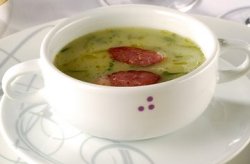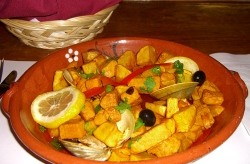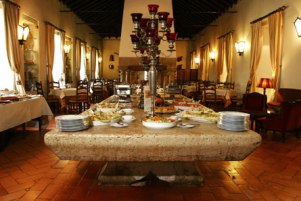Each region of the country has its unique local culinary tradition. Most dishes are simple and nutritious however there are some extraordinary combinations of meat, fish and seafood.
The king of Portuguese cuisine is bacalhau – salty, dried cod cooked in 365 ways and the queen is the sardine.
Portugal is famous for its great, delectable red and white wines from Alentejo, Setúbal, Estramadura, Bairrada and Ribatejo. They are not expensive yet recommendable.
Vinho da casa – home - made wine is worth tasting when you eat out in restaurants, bars or taverns.
Local cheese or meat products for example presunto ham or salty snacks – salgados are also recommendable. The most famous ones are bolinhos de bacalhau – croquettes of potato and cod with seasoning.
The most popular Portuguese dishes:
 SOUPS:
SOUPS:
Caldo verde (green broth) - its basic ingredients are chopped Galician cabbage with potato, sausage, sometimes meat
Açorda (bread soup) - cooked in many ways, basic ingredients are bread with olive and garlic, with fresh herbs. It may contain an egg (a.de alentejana), or seafood (a. de mariscos).
Sopa de mariscos - seafood soup, may contain various types of crustaceans and fish.
FISH:
Bacalhau com nata - cod in cream
Bacalhau a Gomes de Sa- cod with potatoes, onion, black olives and hard - boiled egg
Sardinhas assadas - grilled sardines
Grilled dourada (dourada), robalo (robalo fish) and peixe espada (Swordfish).
...AND SEEFOOD:
Caldeirada – made from dried fish and seafood with vegetables
Arroz de marisco – rice with seafood
Berbigão, amêijoa, mexilhões – species of molluscs, mainly boiled
Polvo – octopus, we recommend salada de polvo (octopus salad)
Lulas cheias – stuffed squids
Lavagante – big lobster (e.g. from Sagres)

MEAT:
Leitao assado – roast piglet
DESSERTS:
Pasteis de nata – cream cakes
Pudim flan – pudding made from egg yolks and milk
Arroz doce – rice pudding with cinnamon and lemon
ALCOHOL:
Porto – strenghtened 20% wine – red, white, dry or sweet
Madera – dark, strenghtened wine, dry or sweet
Vinho verde – rather light, young, delicately sparkling wine
Moscatel de Setúbal – aromatic, strong sweet wine
Ginjinha – cherry vodka
COFFE FOR GOURMANDS:
Bica – small, very strong (espresso)
Carioca – weakened with boiling water (still quite strong!)
Cafe com leite – with milk
Galão – with a lot of frothy milk
Just one more tip!
If you want to taste truly Portuguese food you should choose bars, taverns, caf?s or confectioneries visited mostly by the local people, far from the city centre. There are not many dishes in the menu in such places but they are cheap (about 10 – 15 € for lunch or dinner) and well prepared.
However you have to remember that you can have a meal in these places at certain times: lunch from 12.30 to 3p.m., dinner from 7p.m to 10p.m., that is when the Portuguese have their meals.
A Portuguese Breakfast you can eat in pastelaria, where you can choose something sweet (bolo, doce) or salty (slagados) and drink a morning coffee, juice from fresh fruit or other soft drinks.




